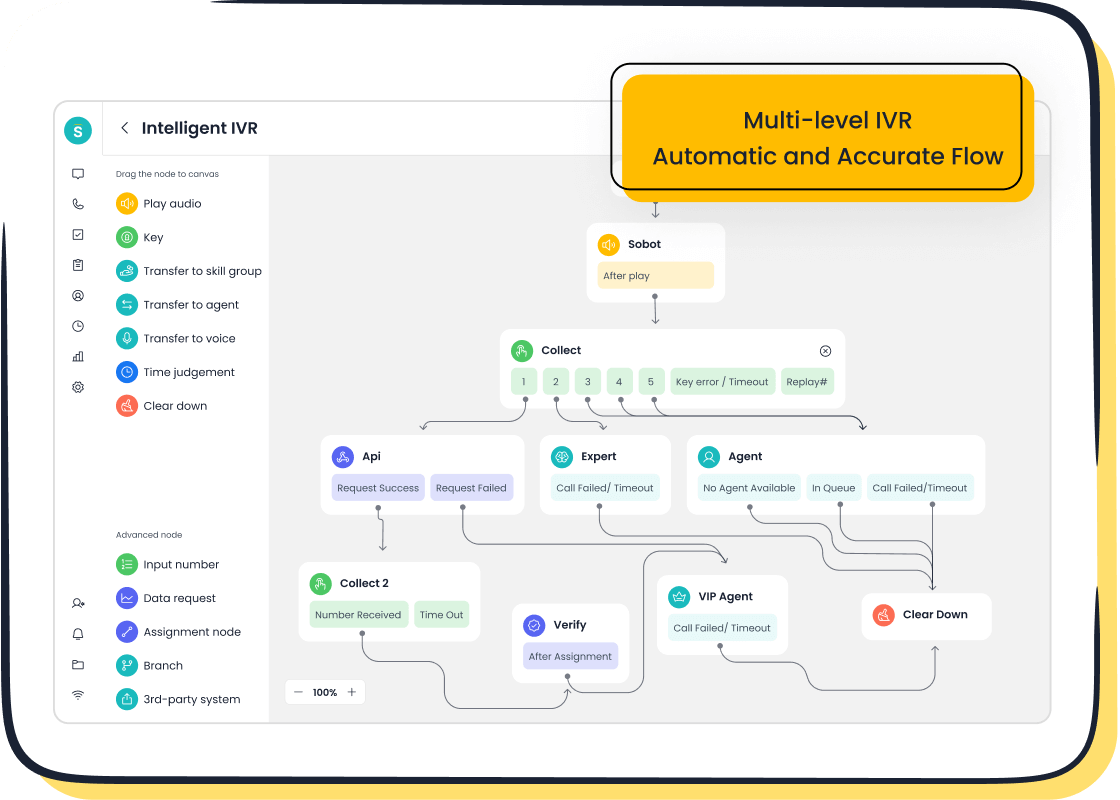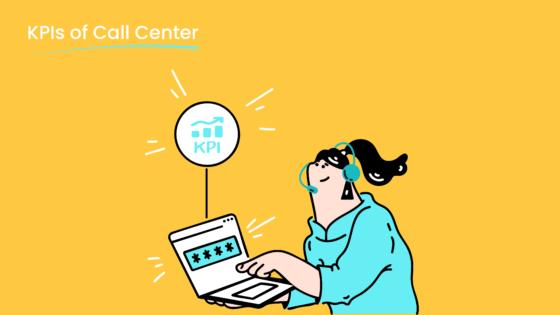10 Must-Have Call Tools for Customer Service Teams

Call tools customer service are transforming the landscape as we approach 2025. With AI tools in the call center industry projected to grow from $1.8 billion in 2023 to $17.05 billion by 2032, businesses must adapt to meet rising customer expectations. These tools enhance customer experience by automating tasks, reducing wait times, and improving satisfaction. Sobot, a leader in intelligent call center solutions, empowers businesses to deliver seamless customer support through innovative tools like live chat and AI-powered voicebots.
Cloud-Based Call Center Software

Definition and Features
Cloud-based call center software is a modern solution that allows businesses to manage customer interactions over the internet instead of relying on traditional on-premise systems. These platforms offer advanced features like real-time monitoring, AI-powered automation, and seamless integration with other customer service tools. They also provide secure remote access, enabling teams to work efficiently from anywhere.
Key features include:
- Scalability: Easily adjust resources as your business grows.
- Flexibility: Support remote teams with secure access.
- Advanced Analytics: Gain insights into customer behavior and agent performance.
- Integration: Connect with CRM systems and other customer service platforms effortlessly.
Benefits for Customer Service Teams
Switching to cloud-based call center solutions can transform how your team operates. Here’s how:
- Improved Efficiency: Automate repetitive tasks and reduce average handle time (AHT).
- Enhanced Scalability: Quickly adapt to changing business needs.
- Cost Savings: Eliminate the need for expensive hardware and maintenance.
- Better Customer Experience: Offer faster response times and higher first-call resolution rates.
- Remote Work Support: Empower agents to deliver excellent customer support from anywhere.
Did you know that 66% of call centers now use cloud-based systems? This shift has improved scalability and remote work capabilities, making it easier for businesses to stay competitive.

Sobot's Voice/Call Center as a Cloud-Based Solution
Sobot’s Voice/Call Center is a standout example of cloud-based call center software. It combines intelligent IVR, AI-powered voicebots, and a unified workspace to streamline operations. With a 99.99% uptime and global network support, Sobot ensures your customer service platform is always live and reliable.
The platform also offers seamless integration with CRM systems, enabling agents to access customer data in real-time. Features like smart call routing and bulk outbound tasks enhance call center efficiency, while advanced analytics help you track performance and improve customer satisfaction. Whether you're managing inbound call center software or outbound campaigns, Sobot’s solution adapts to your needs.
Ready to elevate your customer service? Sobot’s cloud-based tools are designed to help you deliver exceptional experiences every time.
AI-Powered Chatbots and Virtual Assistants
Key Features and Capabilities
AI-powered chatbots and virtual assistants have revolutionized customer support. These tools use advanced technologies like natural language processing (NLP) and machine learning to understand and respond to customer queries in real-time. They’re available 24/7, ensuring your customers always have access to help when they need it.
Here are some standout features:
- Personalization: Chatbots can tailor responses based on customer history and preferences.
- Multilingual Support: Communicate with customers in their preferred language.
- Scalability: Handle thousands of queries simultaneously without breaking a sweat.
- Integration: Seamlessly connect with CRM systems and other customer service tools.
For example, Sobot’s chatbot software leverages AI to deliver personalized, multilingual support. It’s even ChatGPT-enabled, making it smarter and more conversational than ever.
Enhancing Customer Interactions with AI
AI-powered chatbots don’t just answer questions—they transform the customer experience. They reduce response times, improve satisfaction, and create a more engaging interaction. Companies like Delta Airlines and Spotify have seen remarkable results by using chatbots to enhance their services.
| Company | Industry | Impact on Customer Interaction Quality |
|---|---|---|
| Delta Airlines | Airlines | Reduced waiting times and improved travel experiences. |
| Spotify | E-commerce | Boosted user satisfaction with playlist management and troubleshooting. |
Sobot’s chatbot software takes this a step further by integrating with live chat tools. This allows seamless handoffs to human agents when needed, ensuring your customers always get the best support.
Use Cases for Automating Routine Queries
Chatbots shine when it comes to handling repetitive tasks. They can answer FAQs, process orders, and even assist with troubleshooting. This frees up your team to focus on more complex issues.
Here are some key metrics that show how chatbots improve efficiency:
- Average Response Time: Faster replies lead to happier customers.
- Resolution Rate: High rates mean fewer escalations to human agents.
- User Engagement: Positive interactions encourage customers to return.
With Sobot’s chatbot software, you can automate routine queries while maintaining a personal touch. It’s a win-win for both your team and your customers.
Omnichannel Communication Platforms
What Is Omnichannel Communication?
Omnichannel communication is all about creating a seamless experience for your customers across multiple channels. Whether they reach out via email, social media, live chat, or phone, omnichannel platforms ensure every interaction feels connected. Instead of juggling separate systems, you get a unified view of customer interactions, making it easier to provide consistent and personalized support.
Imagine a customer starts a conversation on live chat but later calls your support team. With omnichannel communication, your agents can pick up right where the chat left off. No need for the customer to repeat themselves. This approach not only saves time but also boosts satisfaction by showing customers you value their time.
Benefits of Unified Customer Interaction
Unified customer interaction brings a host of benefits that can transform your customer support strategy. Here’s what you can expect:
- Higher Retention Rates: Companies with strong omnichannel engagement retain 89% of their customers, compared to just 33% for those with weak engagement.
- Increased Revenue: Businesses with robust omnichannel strategies see a 9.5% year-over-year revenue increase, far outpacing the 3.4% growth of weaker companies.
- Improved Efficiency: A unified platform reduces the cost per contact by 7.5% annually, helping you save resources while delivering better service.
| Metric | Omnichannel Performance | Single-Channel Performance |
|---|---|---|
| Customer Retention Rate | 90% | N/A |
| Retention with Strong Engagement | 89% | 33% |
| Revenue Growth | 9.5% | 3.4% |
Omnichannel platforms also drive better customer experience. For example, customers are 47.7% more likely to convert when SMS is part of the communication mix. They also shop 250% more frequently and spend 13% more per order compared to single-channel users.

Sobot's Role in Omnichannel Customer Service
Sobot takes omnichannel communication to the next level. Its platform integrates all your customer contact channels—email, live chat, social media, and phone—into one unified workspace. This means your agents can access customer data and interaction history in real-time, no matter where the conversation started.
With Sobot, you can deliver personalized support that feels effortless. Features like AI-powered chatbots and smart call routing ensure your team handles inquiries efficiently. Plus, Sobot’s tools are designed to scale with your business, making it easier to adapt as your needs grow. By unifying your customer interactions, Sobot helps you improve satisfaction, boost retention, and create a truly connected customer experience.
Workforce Management Tools
Features for Scheduling and Monitoring
Managing your team’s schedule can feel overwhelming, especially during peak times. Workforce management tools simplify this process by offering features like automated scheduling, real-time monitoring, and performance tracking. These tools help you assign shifts, track attendance, and even forecast staffing needs based on historical data.
For example, many tools use AI to predict call volumes, ensuring you always have the right number of agents available. Real-time dashboards let you monitor agent activity, so you can quickly address any issues. This level of visibility helps you maintain smooth operations and deliver excellent customer support.
Sobot’s workforce management solutions integrate seamlessly with its call tools customer service platform. You can monitor agent performance, track key metrics, and adjust schedules—all from one unified workspace.
Benefits for Team Productivity
When your team has clear schedules and performance goals, they work more efficiently. Workforce management tools reduce confusion by automating repetitive tasks like shift assignments and time-off requests. This gives your agents more time to focus on what matters most—enhancing the customer experience.
These tools also improve accountability. Agents can see their performance metrics in real-time, motivating them to meet or exceed expectations. Studies show that teams using workforce management tools report a 20% increase in productivity and a noticeable boost in job satisfaction.
With Sobot, you can empower your team to perform at their best. Its tools provide actionable insights that help you identify areas for improvement, ensuring your team stays productive and engaged.
Applications in Optimizing Call Center Operations
Workforce management tools are game-changers for call center operations. They help you optimize staffing levels, reduce wait times, and improve first-call resolution rates. By analyzing call patterns, these tools ensure you’re always prepared for high-demand periods.
For instance, during a product launch or holiday season, you can use these tools to predict call volumes and adjust staffing accordingly. This proactive approach minimizes customer frustration and boosts satisfaction.
Sobot’s workforce management features take this a step further. They integrate with its customer support platform, allowing you to align staffing with real-time call data. This ensures your team is always ready to deliver exceptional service, no matter the circumstances.
CRM Integration Tools
Definition and Importance of CRM
Customer Relationship Management (CRM) tools are essential for managing and analyzing customer interactions throughout their journey. These tools help you store customer data, track interactions, and streamline communication. By integrating CRM systems with your call tools customer service platform, you can create a unified view of each customer, making it easier to deliver personalized support.
Why does this matter? Imagine having all your customer data—purchase history, preferences, and past interactions—at your fingertips during a call. This level of insight allows you to anticipate needs, resolve issues faster, and enhance the overall customer experience. In fact, businesses that use CRM systems report higher satisfaction rates and improved efficiency.
Benefits of Seamless Data Integration
Integrating CRM systems with your customer support tools offers several advantages. Here’s how it can transform your operations:
- Improved Efficiency: Agents spend less time searching for information and more time solving problems.
- Enhanced Personalization: Access to customer data helps you tailor interactions, boosting satisfaction.
- Streamlined Workflows: Integration eliminates data silos, ensuring smooth communication across teams.
- Better Decision-Making: Analytics from CRM systems provide actionable insights to improve service quality.
Take a look at the impact of CRM integration on key metrics:
| Metric | Improvement |
|---|---|
| Reduction in inbound discussion | 20% |
| Positive feedback rate | 96% + |
| Correct answers by AI platform | 80% |
| Customer satisfaction rate | 95% |
| Self-service question resolution | 22.2% |
| Customer satisfaction score (CSAT) | 97% |
| Problem resolution rate | 85% |
| Customer happiness rate | 99% |
| Sign-off rate increase | 35% |
| COD collection rate increase | 40% |

Sobot's Integration Capabilities with CRM Systems
Sobot makes CRM integration effortless. Its Voice/Call Center solution connects seamlessly with popular CRM platforms, giving your agents real-time access to customer data. This integration ensures every interaction feels personalized and efficient. For example, Sobot’s smart call routing uses CRM data to direct calls to the most suitable agent, reducing wait times and improving first-call resolution rates.
With Sobot, you can also track and analyze customer interactions across channels. This unified approach helps you identify trends, optimize workflows, and deliver exceptional customer support. By integrating CRM systems with Sobot’s tools, you’re not just improving operations—you’re creating happier customers.
Call Center Analytics Tools
Features for Analyzing Customer Calls
Call center analytics tools are game-changers when it comes to understanding your customers. These tools analyze call data to uncover patterns, trends, and insights that can improve your operations. They use technologies like speech analytics, sentiment analysis, and real-time monitoring to evaluate every interaction.
Some standout features include:
- Speech Analytics: Automatically transcribe and analyze conversations to identify keywords, tone, and intent.
- Real-Time Monitoring: Track ongoing calls to ensure quality and compliance.
- Customizable Dashboards: Visualize key metrics like average handle time and first-call resolution rates.
- Predictive Analytics: Forecast customer behavior and call volumes to optimize staffing.
Sobot’s call center analytics tools take these features to the next level. With advanced reporting and analytics, you can monitor agent performance, track customer sentiment, and make data-driven decisions—all from one platform.
Benefits for Understanding Customer Sentiment
Understanding how your customers feel is crucial for delivering great service. Call center analytics tools help you measure customer sentiment by analyzing tone, language, and feedback. This allows you to identify pain points and opportunities for improvement.
Here’s how these tools gather insights:
| Evidence Type | Description |
|---|---|
| Sentiment Analysis | Analyzes customer sentiment and feedback through speech analytics to identify service improvement areas. |
| Customer Surveys | Collects direct feedback on experiences, satisfaction, and expectations. |
| Predictive Analytics | Tracks sentiment trends to reveal the emotional tone of interactions. |
Sobot’s tools excel in sentiment analysis. They provide real-time insights into how customers feel during calls, helping you adjust your approach on the spot. This not only improves customer support but also builds stronger relationships.
Applications in Improving Call Quality
Call center analytics tools don’t just collect data—they help you act on it. By analyzing call quality, you can identify training needs, improve scripts, and enhance overall performance. For example, if analytics show frequent escalations, you can train agents to handle those issues better.
Sobot’s reporting and analytics features make this process seamless. You can track metrics like call duration, resolution rates, and customer satisfaction. These insights help you refine your processes and deliver exceptional service every time. Whether you’re managing inbound or outbound calls, Sobot’s tools ensure your team operates at its best.
Interactive Voice Response (IVR) Systems

Definition and Features
Interactive Voice Response (IVR) systems are automated telephony solutions that interact with callers, gather information, and route calls to the appropriate agent or department. These systems use pre-recorded messages and voice recognition to guide customers through menus, making it easier to resolve issues or find answers without waiting for a live agent.
Key features of IVR systems include:
- Customizable Menus: Tailor options to match your business needs.
- Voice Recognition: Understand customer input for faster navigation.
- Self-Service Options: Allow customers to resolve common issues independently.
- Call Routing: Direct calls to the right agent or team based on customer input.
Benefits for Streamlining Call Routing
IVR systems simplify call routing, ensuring customers reach the right person quickly. This reduces wait times and improves first-call resolution (FCR) rates. For example, companies like Telefonica Germany and Swisscom have seen significant improvements in call handling and cost savings by implementing IVR systems.
| Company | Key Outcomes |
|---|---|
| Telefonica Germany | Major improvements in call handling and routing, providing 24/7 support with voice response. |
| Swisscom | Handled over 10 million customer interactions annually, saving millions of euros since implementation. |
Sobot's Intelligent IVR in Action
Sobot’s IVR system takes automation to the next level. It uses AI-powered voice recognition to understand customer intent and route calls efficiently. With features like drag-and-drop menu creation and real-time updates, you can customize workflows in minutes.
Sobot’s IVR also boosts FCR rates, which directly impacts customer satisfaction. For every 1% increase in FCR, customer satisfaction improves by 1%. Sobot’s solutions achieve a 95% satisfaction rate, with 85% of problems resolved on the first call. Self-service options handle 22.2% of queries independently, freeing up agents for complex issues.
| Metric | Impact on Customer Satisfaction |
|---|---|
| 1% increase in FCR | 1% increase in CSAT |
| Enhanced call routing | Higher FCR |
| Self-service options | Resolves issues in one call |
By integrating Sobot’s IVR into your call tools customer service platform, you can deliver faster, more efficient customer support while improving satisfaction.
Call Recording and Quality Monitoring Tools
Features for Recording and Reviewing Calls
Call recording and quality monitoring tools are essential for improving your customer interactions. These tools let you record calls, review them later, and analyze agent performance. They often include features like automatic call transcription, keyword detection, and sentiment analysis. You can even set up alerts for specific phrases or compliance triggers.
For example, Sobot’s call recording tools allow you to store and review calls securely. With real-time monitoring, you can listen in on live calls and provide immediate feedback to your team. This ensures your agents stay on track and deliver consistent service.
Benefits for Training and Compliance
These tools are a game-changer for training and compliance. By reviewing recorded calls, you can identify areas where agents need improvement. For instance, if 14% of agents miscommunicate a policy, you can address it before it confuses customers.
Compliance monitoring also becomes easier. Tools automatically flag potential violations, helping you avoid penalties. Plus, they provide evidence for audits or disputes. Companies using these tools report an 8-12% boost in agent efficiency and a 15-25% drop in turnover.
| Evidence Type | Description |
|---|---|
| Compliance Monitoring | Flags violations and provides evidence for audits. |
| Proactive Risk Management | Identifies issues before they escalate. |
| Improved Training Effectiveness | Corrects agent errors, like policy miscommunication. |
| Financial Benefits | Boosts efficiency, reduces turnover, and increases retention. |
| ROI Connection | Every 5-point quality score increase adds 3% to customer retention revenue. |
Applications in Enhancing Service Quality
Call monitoring tools directly improve service quality. Real-time monitoring helps you spot issues as they happen, while detailed reports highlight trends and areas for improvement. Companies with strong quality assurance programs see 35% higher customer satisfaction rates.
Sobot’s tools provide actionable insights to refine your approach. They empower your agents, reduce escalations, and optimize quality assurance. This ensures your call tools customer service platform delivers exceptional customer support every time.
| Feature | Benefit |
|---|---|
| Real-time Monitoring | Identifies areas needing improvement, enhancing customer experiences. |
| Comprehensive Reporting | Tracks performance metrics and pinpoints specific areas for improvement. |
| Actionable Insights | Refines service approaches by understanding customer pain points. |
Collaboration and Knowledge Management Platforms
Features for Team Collaboration
Collaboration platforms are the backbone of effective teamwork. They bring your team together, no matter where they are, and make communication seamless. These tools often include features like real-time messaging, file sharing, and task management. Some even offer video conferencing and shared workspaces to keep everyone on the same page.
For example, Sobot’s unified workspace integrates all communication channels, allowing your team to collaborate effortlessly. Whether it’s sharing customer insights or brainstorming solutions, these platforms ensure your team stays connected and productive.
Benefits for Knowledge Sharing
Knowledge management platforms take collaboration to the next level by centralizing information. They act as a single source of truth, making it easy for your team to find answers and share expertise. Here’s how they help:
- Increased first-contact resolution rates by giving agents quick access to centralized information.
- Robust self-service options for customers, reducing routine inquiries.
- Consistent customer experiences across channels, building trust.
- Higher customer satisfaction scores due to faster issue resolution.
- Scalable support operations that grow with your business.
- Actionable insights from stored interactions to guide future strategies.
With Sobot’s knowledge management tools, you can create a centralized hub for all your customer support needs. This not only improves efficiency but also enhances the overall customer experience.
Use Cases in Resolving Complex Issues
Collaboration and knowledge management platforms shine when tackling complex problems. Imagine a scenario where a customer has a unique issue. Your team can quickly access past interactions, consult troubleshooting guides, and even collaborate with other departments to find a solution.
Metrics show how these platforms improve teamwork:
| Metric | Description |
|---|---|
| Communication Frequency | Tracks how often team members engage, boosting collaboration. |
| Project Completion Rates | Measures on-time project delivery, reflecting teamwork efficiency. |
| Knowledge Sharing | Evaluates how well information flows among employees. |
| Cross-Functional Collaboration | Tracks successful interdepartmental projects, fostering a collaborative culture. |
| Feedback and Recognition | Monitors feedback quality, keeping teams motivated and engaged. |
Sobot’s tools make resolving complex issues a breeze. By combining collaboration features with a robust knowledge base, your team can deliver faster, more accurate solutions. This ensures your call tools customer service platform operates at peak efficiency.
Predictive Dialer Software
Definition and Features
Predictive dialer software is a tool that automates outbound calls, connecting agents only when a recipient answers. It uses algorithms to predict when agents will be available and adjusts the dialing speed accordingly. This eliminates idle time and ensures agents spend more time talking to customers instead of waiting for calls to connect.
- Call Progress Analysis: Distinguishes between human responses and voicemail, reducing dropped calls.
- Real-Time Adjustments: Optimizes dialing speed based on agent availability.
- Integration Capabilities: Connects seamlessly with CRM systems for better customer data access.
Companies like Five9 have reported significant improvements in agent productivity by using predictive dialers. These tools are becoming essential for businesses that want to maximize efficiency and engage customers effectively.
Benefits for Outbound Call Efficiency
Predictive dialers are game-changers for outbound call efficiency. They automate the dialing process, allowing agents to focus on conversations rather than manual tasks. This boosts productivity by 200-300% compared to manual dialing.
Here’s why predictive dialers are so effective:
- They eliminate idle time, ensuring agents stay productive.
- They reduce the manual effort required to initiate calls.
- They improve call success rates by connecting agents only when a recipient answers.
Businesses using predictive dialers often see better customer engagement and operational efficiency. For example, LumenVox’s Call Progress Analysis software has helped companies reduce dropped calls and improve outbound call success rates.
Applications in Sales and Customer Outreach
Predictive dialer software isn’t just about efficiency—it’s a powerful tool for boosting sales and customer outreach. By automating calls and optimizing workflows, it helps you reach more leads and close more deals.
Take a look at the impact predictive dialers can have:
| Metric | Improvement Percentage |
|---|---|
| Staffing Requirements | Up to 30% reduction |
| Conversion Rates | 15% to 50% increase |
| Lead Generation | 200% more leads |
| Appointment Setting Rates | 20% increase |
Imagine your sales team generating 200% more leads or increasing conversion rates by up to 50%. Predictive dialers make this possible by ensuring every call counts. Sobot’s Voice/Call Center integrates predictive dialing with smart call routing and CRM systems, giving your team the tools they need to succeed. Whether you’re reaching out to new customers or following up on leads, predictive dialers help you deliver better customer support and drive results.
Adopting these 10 tools is essential for transforming your call tools customer service strategy in 2025. They enhance efficiency, improve customer satisfaction, and streamline operations. Sobot’s solutions, like its Voice/Call Center, unify customer support channels, optimize workflows, and deliver real-time insights. Stay ahead—explore Sobot’s offerings to elevate your customer experience.
FAQ
What are the key benefits of using call tools for customer service?
Call tools improve efficiency, reduce wait times, and enhance customer satisfaction. They also streamline workflows, making it easier for your team to deliver exceptional customer support.
How does Sobot ensure system reliability for its call tools?
Sobot guarantees 99.99% uptime for its call tools, supported by a global network. This ensures your customer support operations remain uninterrupted and reliable, even during peak times.
Can call tools integrate with existing CRM systems?
Yes, most call tools, including Sobot’s Voice/Call Center, integrate seamlessly with CRM systems. This allows agents to access customer data in real-time, improving personalization and efficiency.
See Also
Best 10 AI Solutions for Enterprise Contact Centers
2024's Leading 10 Speech Analytics Tools for Call Centers
2024's Top 10 Customer Service Software Solutions